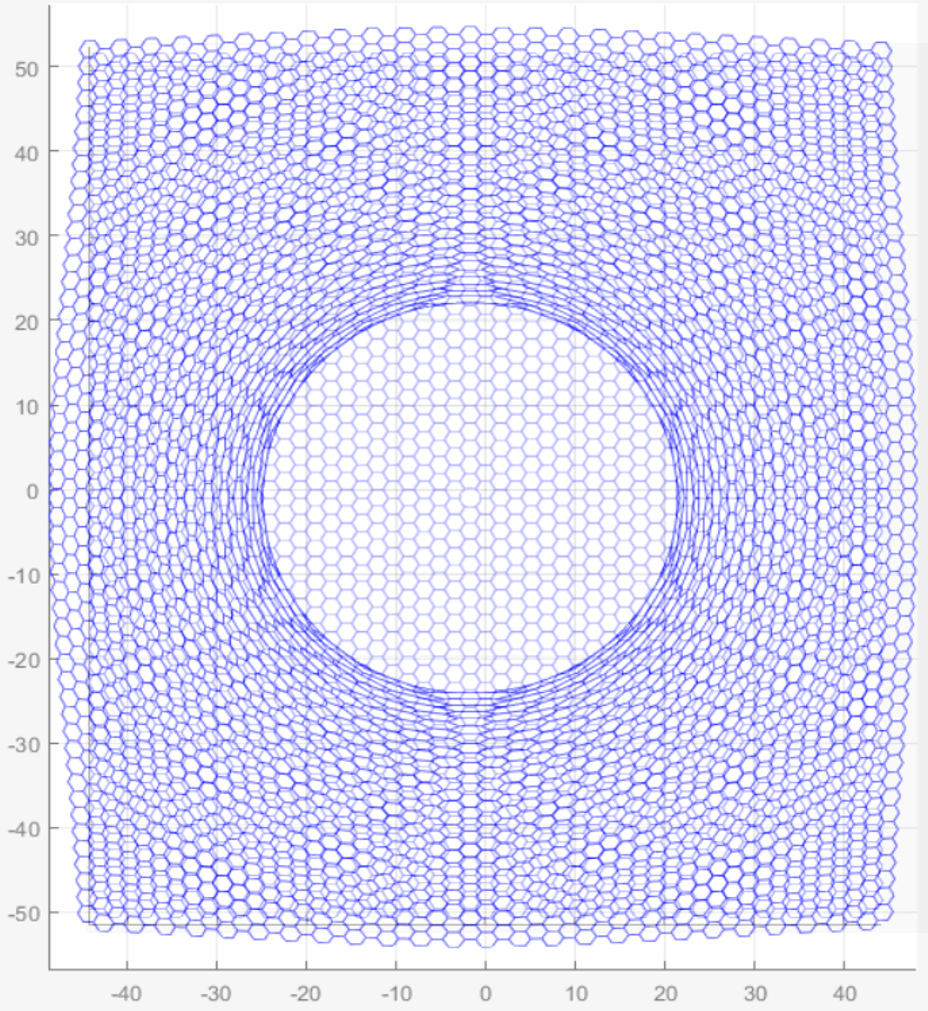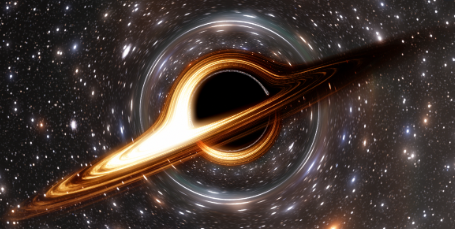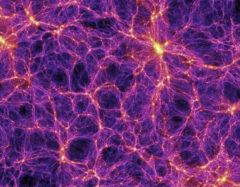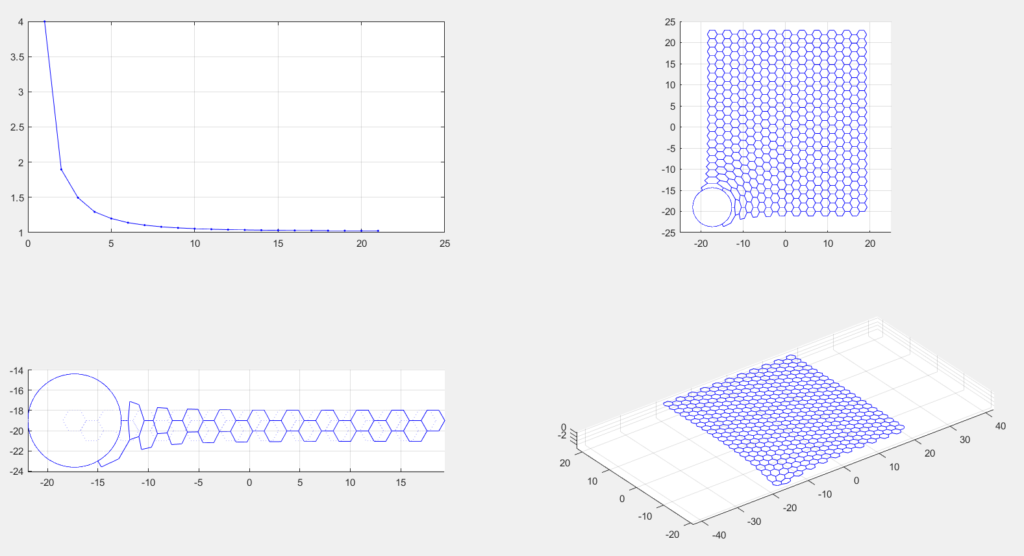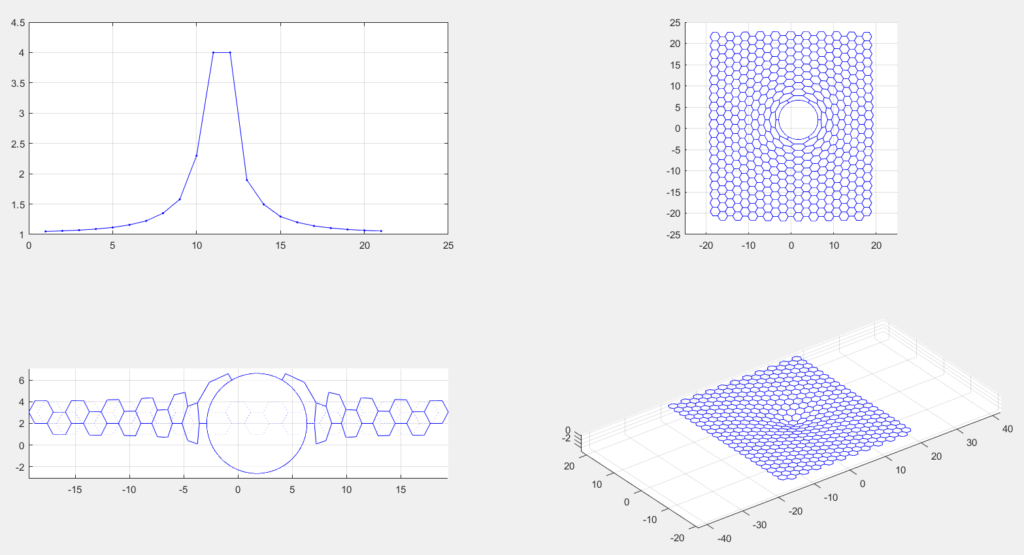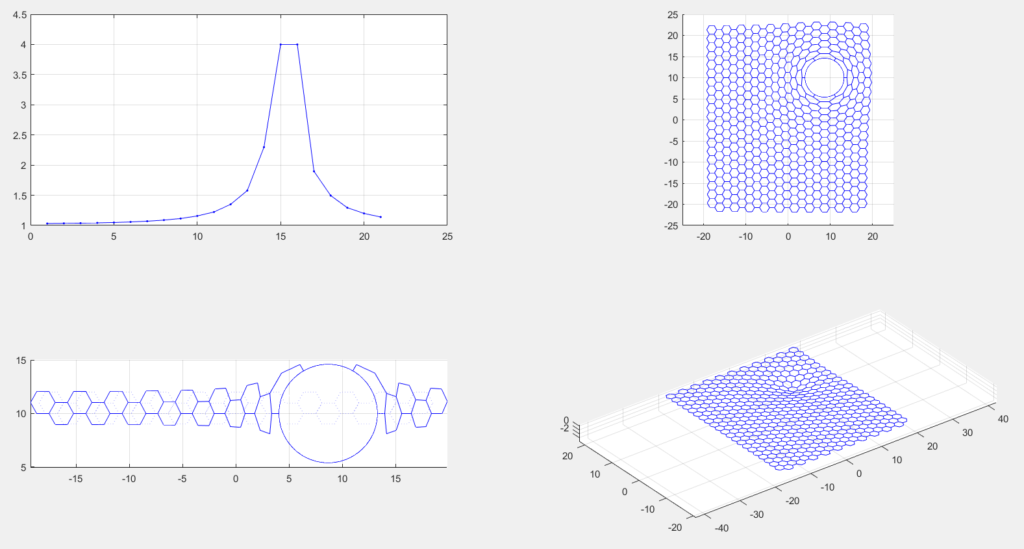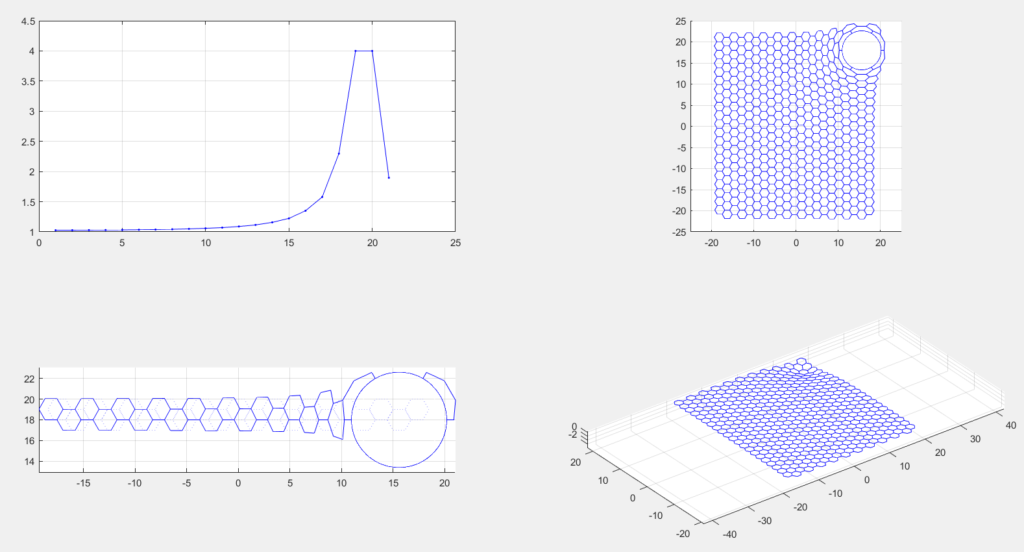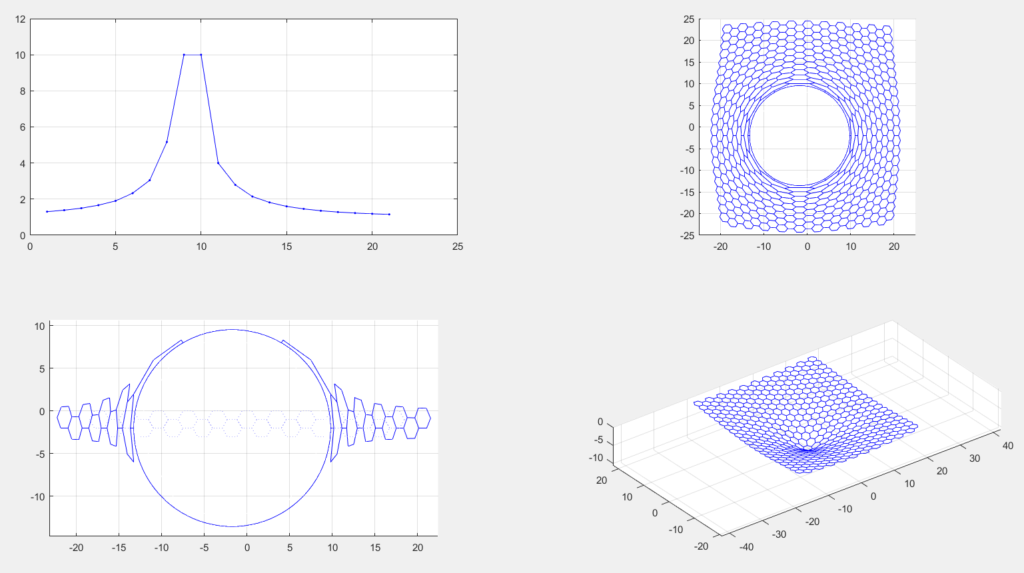Summary
In a nutshell, the theory says that the fabric of space-time is made up of tiny Planck-length cells. These cells divide spontaneously and independent of each other, halving their size. Matter and energy exists in the form of particles and waves traveling on the surface of the cells. Before the Big Bang, the entire universe existed as one gigantic universe-sized cell with all the matter and energy that would ever exist in a frenzied jumble of particles and waves on its surface. Time began when the cell divided into two, thus starting the first ‘tick’ of the universe’s clock. The universe from an external, hyper-dimensional standpoint has always been the same size. Occupants within the universe, the internal view, observe it expanding as the number of cells between an observer and an object increases. An occupant within the universe could observe or measure at best (theoretically) distances of one Planck-length per cell. Occupants of the universe will observe each cell as one Planck-length even though the cells themselves are not necessarily the same size. When matter with mass transfers onto the surface of a cell, that cell swells, its surface area and diameter increasing slightly proportional to its mass. Cells with many, many mass-bearing particles on them can therefore be much larger than non-mass-bearing cells, as is the case with black holes. The external viewer sees black holes as large swollen cells, whereas the internal viewer observes every cell the same size. Gravity is a result of the pressure exerted upon neighboring cells pushing back towards the larger cell in the middle. Cells near a black hole, for instance, are greatly squeezed and flattened. This flattening drops of at one over the radius squared. Therefore zooming out sufficiently from a black hole and looking at the region of space around a black hole, the average cell diameter returns to normal, and the region contains the same number of cells and an empty region without a black hole. The cells themselves do not move and are immortal; rather particles and waves move from cell to cell and the cells create a lattice on which the observable universe exists. The external viewer sees the universe getting finer and finer, whereas the internal viewer sees it getting bigger and bigger.
The image below is a supercomputer simulation of the universe at its current age depicting how galaxies, galaxy-clusters, and super galaxy clusters form along twisted, intersecting lines called filaments. I believe these filaments are an artifact of space-time cell division in the early universe, as particles tended to coalesce along cell boundaries, revealing the cellular structure of the fabric of space-time.

Introduction
I’m always thinking…about the universe, about God, about the mundane things of life, etc.
Regarding the universe, I’ve had ideas about the universe’s true structure for several years now. What’s the probability of my ideas being right? Slim to none to be optimistic. Nevertheless, there are many facets of my ideas that seem to fit with what physicists are currently observing and pondering.
I believe it was Einstein who coined the phrase, “the fabric of space” (It may have been a physicist named William Clifford around 1850). Before General Relativity, most scientists thought space was just an empty vacuum; but since General Relativity, space seems to be something since it can be warped and stretched. It was here where my thought process began, “what could the fabric of space-time be?”
I’m sure it’s because I’m just a regular person and not a physicist, but I’ve thought there must be some mechanical or physical connection between objects in space in order for gravity to attract them to each other. After all, we’ve all seen the 2D demonstration of gravity on a trampoline with two balls. The primary heavy ball makes a dent in the surface which causes the lighter one to curve towards it as it rolls by. Here the fabric actually is a fabric. Why couldn’t space be some sort of invisible 3D fabric (at least invisible to those in the universe) where objects move through it without friction and vibrate creating ever-expanding ripples and waves? Apparently this idea that space is something has been considered before and was called the Aether, but I only found out about this later on. So I guess I’m an “Aetherist”.
Well, enough of an introduction. Let’s get to what I think the aether might be.
Imagine the universe as a single “cell” sitting in a black expanse. The expanse in which it sits is a hyper dimension of space and time outside of our universe and inaccessible to the in the universe. Any animation you have seen of the Big Bang where the camera is looking at a dot that suddenly explodes assumes this hyper dimension. That’s because before the Big Bang the universe in which we live had no space in it and time stood still (i.e. there was no time). If you could somehow exist in the primordial universe, you would measure its diameter as 0 and your clock would be at 0 and not be ticking. If a hyper dimension existed outside of the universe, like say where God lives, and you resided in this dimension, then you could sit outside the primordial universe looking at it and you could have a hyper-dimensional clock that was ticking. Let’s say that is case.
As you sit in hyperspace, and you measure the infant pre-Big Bang universe, how big do you think it would be? Well it turns out is doesn’t matter. Any sense of dimension and any sense of time in hyperspace is not related to dimension and time within our universe. You can say that the universe has a diameter and that it’s not a singularity, but that’s about it. You could say it’s one inch across or one quadrillion light years across—the fact is hyper-dimensional measurements don’t correspond to measurements within our universe.
Getting back to the cell—the cell is the universe. I call it a cell because it has a membrane and it’s roughly spherical. Unlike cellular life that’s filled with cytoplasm and various organelles, it doesn’t matter what space-time cells are filled with or if they’re filled with anything at all. All the action is on the surface of the cell. Our entire universe is just one cell in its pre-Big Bang state, and all the energy our universe will ever have is moving around on the surface of the cell in the form of various particles, vibrations, and waves. The particles are so densely packed, that they collide and turn into other particles and make waves. Basically the membrane of the cell is alive with particles, waves and energy. But how could all this be happening if the clock of the universe still reads zero? It’s because time in the universe is a function of particles and waves moving between Space-Time Cells (STC), but there’s only one cell at this time so no semblance of time can pass. The particles and waves move along the cell’s surface in hyper dimensional time (both before the Big Bang and after it). This is how the particles and waves can be moving on the primordial cell’s surface even though time has not yet begun.
As I’ll explain later, gravity is a function of relative pressures between cells, so when there’s only one cell or even many cells with the same energy content, there’s no force of gravity. It’s an important point because I’ve often wondered what could cause the primordial singularity universe to “explode”. The gravity of all the matter and energy in the whole universe collapsed down into a singularity would be so immense, what could cause it to explode? It would be extremely stable with all that gravity, right? Well in the STC theory, there would be no gravity.
What was the advent of time? I don’t know why, but STCs occasionally divide into two. It’s another reason why I call them cells. I didn’t come up with the idea of STCs because there’s an organic analogy between them and biological–it’s just a coincidence.
At any rate, STCs divide occasionally. The daughter cells are roughly the same size and same surface area as each other, but half the size of the original cell. This first division, which I call the “Big Split”, is the beginning of time in our universe–it is in fact what we call the Big Bang. As the cell divides, the particles and waves on its surface quickly adjust redistribute themselves along the two surfaces. Thus half the energy of the universe is on one cell and the other half is on the other. Not to say it’s precisely divided 50/50. The motion of the particles and waves is rather random, so one side might have a little more energy than the other, but they are nearly identical.
Because they of nearly identical, gravity still doesn’t exist yet. Gravity will not exist until there’s a sufficient number of cells in order for the slight variation of particles had some significance. I believe what happens at this stage of the universe is what scientists call “inflation”. Inflation is an as yet unknown behavior of the universe where it rapidly went from much smaller than a proton to a macroscopic size nearly instantaneously. I say “macroscopic” because I’ve heard sizes anywhere from just under 1 mm to 20 cm. For the sake of this blog, let’s say it is one 1 mm. The Inflation theory was necessary to explain how the distribution of energy around the universe is so uniform.

Once physicists started getting accurate and detailed images of the Cosmic Microwave Background (CMB), pictured above, they were amazed at just how uniform the energy distribution was. Many of you have seen the image with random patterns of blue to red pixels, but the temperature difference from the hottest red to the coldest blue is only several hundred thousandths of a degree Celsius. How could energy be so uniformly distributed if one part of the universe could not “communicate” with another given the speed of light? The answer physicists came up with is inflation. If the universe blossomed almost instantaneously, then matter and energy would exhibit this smooth uniformity.
I’m not saying inflation didn’t happen–I’m just saying that since the force of gravity was insignificant until certain regions of space had a considerably smaller amount of energy is them compared to others. The universe at 1 mm would be 6.25e31 Planck lengths across, and therefore the number of STCs across, and roughly around 1.28e95 cells in the sphere that is the universe. That’s a considerable number. If the numbers of cells doubled at the maximum possible rate of one division every Planck time period, then it would only take 316 Planck periods to reach this number. 316 Planck periods is only 1.70e-41 seconds–which is basically instantaneously. The STCs wouldn’t necessarily have to divide any this rate, but this is the fastest the universe could have gotten to this size.
